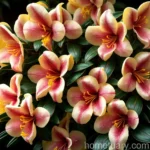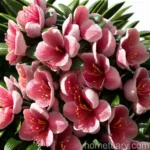Understanding the Fascinating Rhododendron ‘Scintillation’
What is Plant: Rhododendron (Rhododendron ‘Scintillation’)
Rhododendron ‘Scintillation’ is a stunning evergreen shrub that belongs to the family Ericaceae. Rhododendrons are known for their vibrant and abundant blossoms, making them a popular choice for gardens and landscapes. The ‘Scintillation’ variety is specifically admired for its elegant, wavy-edged flowers and beautiful foliage. This plant is a hybrid of the Catawbiense species and displays an exceptional profusion of pale pink blooms, adding a touch of elegance to any garden space.
Key Takeaways – Rhododendron (Rhododendron ‘Scintillation’)
Culture
- This plant thrives in well-drained, slightly acidic soil and requires minimal care once established.
- Suitable for woodland gardens, urban gardens, or as a border plant, offering versatility in its application within varying garden styles.
- It is essential to ensure sufficient air circulation to prevent the onset of certain diseases and encourage healthy growth.
Uses
- Rhododendron ‘Scintillation’ is widely used in landscaping and garden design due to its captivating flowers and attractive foliage.
- It serves as an excellent accent plant, adding color and texture to the garden, and is often used in mixed borders or container plantings.
Water
- The plant requires regular watering, especially during the drier periods, to maintain soil moisture levels.
- Proper irrigation management is critical to prevent waterlogged conditions, which can lead to root rot and other diseases.
Sunlight
- Partial shade to full sun exposure is ideal for the healthy growth and development of Rhododendron ‘Scintillation’.
- While the plant tolerates partial shade, it thrives in locations with dappled sunlight and protection from harsh afternoon sun.
Fertilizer
- The application of a balanced, slow-release fertilizer in the spring supports the plant’s growth and enhances its floral display.
- Avoid excessive use of fertilizers high in nitrogen, as this can lead to lush foliage growth at the expense of flower production.
Soil
- Well-drained, acidic soil with a pH range of 4.5 to 6.0 is crucial for the optimal growth of Rhododendron ‘Scintillation’.
- Incorporating organic matter such as peat moss or compost improves soil structure and fertility, creating an ideal growing environment for the plant.
Pruning
- Pruning is generally minimal and primarily focuses on the removal of dead or damaged branches, shaping the plant, and promoting air circulation.
- Regular deadheading of spent flowers helps maintain a tidy appearance and encourages the formation of new buds.
Propagation
- Propagation can be achieved through methods such as softwood cuttings, layering, or grafting, offering opportunities to expand plantings or share the beauty of the ‘Scintillation’ variety with others.
- Propagation endeavors should be carried out with care and attention to ensure the successful establishment of new plants.
Container
- Rhododendron ‘Scintillation’ can thrive in containers, offering an excellent option for those with limited garden space or those seeking to create attractive patio displays.
- Proper container selection, well-drained potting mix, and regular maintenance are essential for successful container gardening with this plant.
Popularity
- The ‘Scintillation’ variety is celebrated for its stunning and abundant pale pink flowers, capturing the interest of garden enthusiasts and plant lovers.
- Its popularity in gardens and landscapes stems from its remarkable ornamental features and ease of cultivation.
Common Diseases
- Rhododendron ‘Scintillation’ is susceptible to certain diseases such as Phytophthora root rot, powdery mildew, and bud blast, highlighting the importance of disease prevention and integrated management strategies.
Disease Diagnosis
- Regular monitoring for symptoms such as wilting, leaf discoloration, or abnormal growth can aid in the early diagnosis of potential diseases, allowing for prompt intervention and treatment.
Common Pests
- Common pests that may affect Rhododendron ‘Scintillation’ include lace bugs, weevils, and caterpillars, necessitating vigilance and appropriate pest control measures to protect the plant’s health.
Botanist’s Tips
- Collaborating with a horticulturist or botanist provides invaluable insights into the care, maintenance, and optimal growing conditions for Rhododendron ‘Scintillation’.
- Seeking expert advice can enhance the overall success and enjoyment of cultivating this beautiful plant.
Fun Facts
- The name “Rhododendron” is derived from the Greek words “rhodos” and “dendron,” translating to “rose” and “tree” respectively, reflecting the plant’s association with vibrant blossoms and woody growth.
- Rhododendrons are also symbolic of various meanings, including beauty, caution, and spiritual significance in different cultures and traditions.
Links to External Resources
For further information, guidance, and inspiration related to Rhododendron ‘Scintillation’ and the captivating world of plants, consider exploring the following resources:
- American Rhododendron Society: American Rhododendron Society
- Royal Horticultural Society: RHS – Rhododendrons
- The American Phytopathological Society: Diseases of Rhododendron
With a deeper understanding of the key considerations and characteristics associated with Rhododendron ‘Scintillation’, you can embark on a fulfilling journey of nurturing and appreciating this remarkable plant.
As a plant scientist, my passion for understanding and unlocking the potential of diverse plant species continually inspires my exploration of the rich botanical world. In this blog post, the focus is on unraveling the captivating attributes of Rhododendron ‘Scintillation’ and providing comprehensive insights into its care, cultivation, and ornamental value. By delving into the essential aspects of culture, uses, and maintenance, we aim to equip plant enthusiasts and horticulturalists with the knowledge and guidance needed to cultivate and appreciate the beauty of this exceptional rhododendron variety.
Taking a deep dive into the world of Rhododendron ‘Scintillation’ allows for an appreciation of its botanical significance, aesthetic appeal, and the intricate balance of factors influencing its growth and development. Whether you are an avid gardener, a landscape designer, or simply a lover of plants, the exploration of this unique botanical specimen holds the promise of discovery, learning, and the sheer joy of nurturing nature’s wonders.
The evolving landscape of horticulture and gardening is enriched by the diversity of plant species and the contributions of individuals dedicated to unlocking their potential. Through this blog post, we aim to contribute to the collective knowledge base surrounding Rhododendron ‘Scintillation’, fostering an appreciation for its distinctive qualities and the art of cultivating and caring for this exquisite plant.
I invite you to embark on this journey of discovery, exploration, and enrichment as we navigate the realm of Rhododendron ‘Scintillation’ and celebrate the diverse and captivating tapestry of plant life.
Let’s dive into the unique world of Rhododendron ‘Scintillation’ and unlock the secrets of its beauty and resilience, guided by the expert insights and comprehensive information presented within this blog post.















